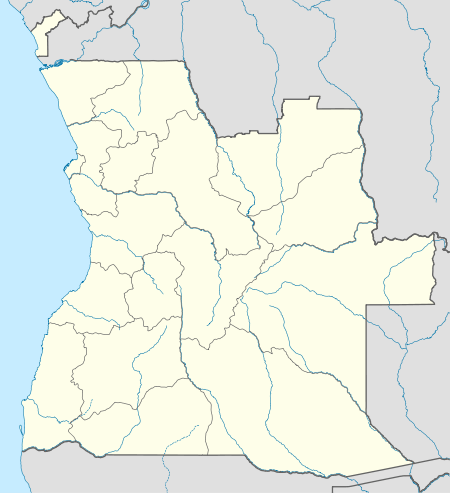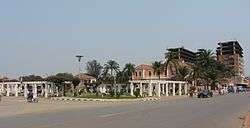Malanje
| Malanje | |
|---|---|
| Municipality and town | |
|
Center of Malanje | |
 Malanje Location in Angola | |
| Coordinates: 9°32′S 16°21′E / 9.533°S 16.350°E | |
| Country |
|
| Province | Malanje Province |
| Area | |
| • Total | 2,422 km2 (935 sq mi) |
| Elevation | 1,155 m (3,789 ft) |
| Population (2009) | |
| • Total | 156,829 |
| • Density | 65/km2 (170/sq mi) |
| Time zone | WAT (UTC+1) |
| Climate | Aw |
Malanje (also Malange) is the capital city of Malanje Province in Angola with a population of approximately 222,000. It is located 380 kilometres (240 mi) east of Angola's capital Luanda. Near it are the spectacular Calandula waterfalls, the rock formations of Pungo Andongo, and the Capanda Dam. The climate is mainly humid, with average temperatures between 20 and 24 °C (68 and 75 °F) and rainfall 900 to 130 millimetres (35.4 to 5.1 in) in the rainy season (October to April).
History
Portuguese rule
Portuguese settlers founded Malanje in the 19th century. The construction of the railway from Luanda to Malanje, in the fertile highlands, started in 1885. The environs of Malanje included the principal cotton-producing area of Portuguese West Africa and drove its development since the beginning. The town developed in the mid-19th century as an important feira (open-air market) on Portuguese Angola's principal plateau, between Luanda — the territory's capital and largest city, 350 kilometres (220 mi)[1] to the west – and the Cubango River valley, inhabited by Northern Mbundu peoples, 200 km (120 mi) to the east. Situated at an elevation of 1,134 metres (3,720 ft),[2] the town had a high-altitude tropical climate, ideal to several agricultural productions. The city developed as an important agricultural, manufacturing, trading and services centre. Its productions included cotton, textiles, coffee, fruit and corn, and among its facilities it had cinema, hospital, railway station and airport.[3] The Cangandala National Park, was established by the Portuguese authorities on 25 June 1970, having previously been classified as an Integral Natural Reserve on 25 May 1963.
After independence from Portugal
The withdrawal of the Portuguese in conjunction with Angola’s independence in 1975, and, later, the Angolan Civil War (1975–2002), severely hampered the production of cotton as well as that of coffee and corn (maize). Malanje was partially destroyed during the civil war, but reconstruction efforts in the years following the end of the conflict have rebuilt the city and its surroundings.
Landmarks
Near the city is the Cangandala National Park, established by the Portuguese authorities on 25 June 1970, it was founded to protect the Giant Sable Antelope which were discovered in 1963. As far as religious buildings are concerned, there is the Evangelical Church at Quêssua and as for funerary constructions, the Tomb of the queen Ana de Sousa Nzinga Mbande and the tomb of José do Telhado, a local Robin Hood. José do Telhado was a white Angolan that in colonial days used to steal from rich whites and distribute to poor blacks. Worth visiting is the Forte de Cabatuquila in the city.
Transportation

Airport
Malanje Airport was built during the colonial era. Currently, there are no flights to the capital Luanda.
Railway
The construction of the railway from Luanda to Malanje, in the fertile highlands, started in 1885. After the end of the civil war in 2002, it was expected to be the terminus of a railway from the capital city and port of Luanda once reconstruction was complete.
See also
References
- ↑ "Distance between Luanda and Malanje". Distancefromto.net. distancefromto.net. 2015. Retrieved 7 September 2015.
- ↑ "Geographic coordinates of Malanje, Angola". dateandtime.info. dateandtime.info. 2015. Retrieved 7 September 2015.
- ↑ MalanjeAnosOuro.wmv, a film of Malanje, Overseas Province of Angola (before 1975).
Coordinates: 9°32′S 16°21′E / 9.533°S 16.350°E
